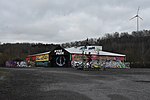Schleptruper Egge
Hills of Lower SaxonyOsnabrück (district)Wiehen Hills

The Schleptruper Egge is a hill, 148 m high, in the Bramsche parish of Schleptrup and is part of the Wiehen Hills. To the north is the bog of Großes Moor at a height of about 47 m above sea level (NHN), the Mittelland Canal built in the 20th century and the Bramsche parish of Kalkriese. Immediately east of the Schleptruper Egge runs the A 1 motorway, the so-calle Hanseatic Line (Hansalinie). On the top of the Schleptruper Egge is the mast of the NDR Osnabrück-Engter Transmitter. The long distance path of Hünenweg, managed by the Weser-Ems Wiehen Hills Society (Wiehengebirgsverband Weser-Ems), which runs from Osnabrück to Papenburg, also leads over the Schleptruper Egge.
Excerpt from the Wikipedia article Schleptruper Egge (License: CC BY-SA 3.0, Authors, Images).Schleptruper Egge
Zum Fernsehturm,
Geographical coordinates (GPS) Address Nearby Places Show on map
Geographical coordinates (GPS)
| Latitude | Longitude |
|---|---|
| N 52.374297 ° | E 8.03117 ° |
Address
Zum Fernsehturm 18
49565
Lower Saxony, Germany
Open on Google Maps








